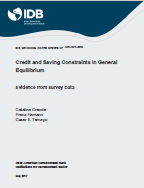Credit and Saving Constraints in General Equilibrium: Evidence from Survey Data
Date
May 2017
In this paper, we build a heterogeneous agents-dynamic general equilibrium model wherein saving constraints interact with credit constraints. Saving constraints in the form of fixed costs to use the financial system lead households to seek informal saving instruments (cash) and result in lower aggregate saving. Credit constraints induce misallocation of capital acrossproducers that in turn lowers output, productivity, and the return to formal financial instruments. We calibrate the model using survey data from a developing country where informal saving and credit constraints are pervasive. Our quantitative results suggest that completely removing saving and credit constraints can have large effects on saving rates, output, TFP,
and welfare. Moreover, we note that a sizable fraction of these gains can be more easily attained by a mix of moderate reforms that lower both types of frictions than by a strong reform on either front.
and welfare. Moreover, we note that a sizable fraction of these gains can be more easily attained by a mix of moderate reforms that lower both types of frictions than by a strong reform on either front.



